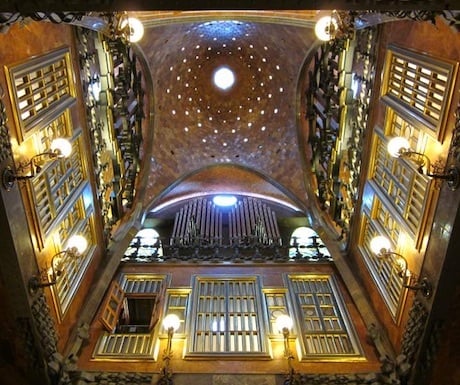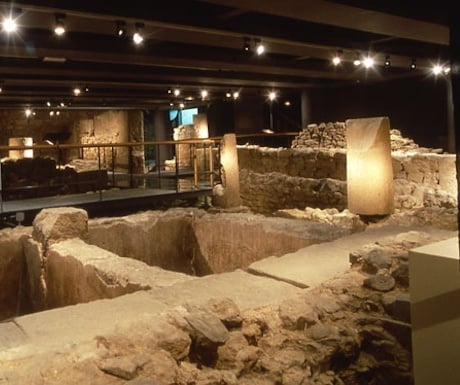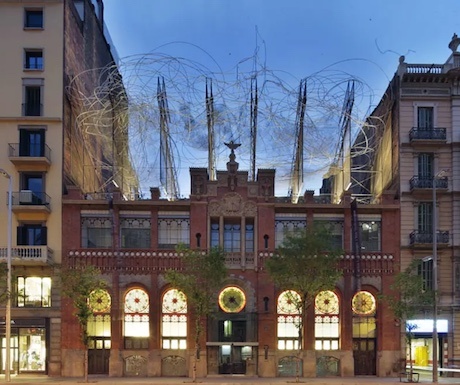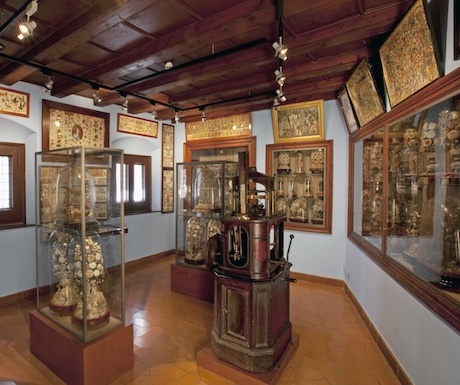Attractions · Europe · Going Out · Leisure Travel · Regions · Spain · Speciality Travel · Western Europe
5 of the best art and architecture stops in Barcelona, Spain
The versatility of Barcelona makes it one of the most popular tourist spots in Europe: cosmopolitan city, golden beaches, historic monuments, modern design hotels, cutting-edge cuisine – whether you want a relaxing break or a culture-filled trip, Barcelona is the perfect holiday destination. Even if sun-loungers and sangria are more your thing, dont miss out on some of the incredible art and architecture Barcelona has to offer: from the revolutionary paintings of Picasso to the architectural brilliance of Gaudí.
 Heres our list of the best art and architecture stops in Barcelona:
Museu Picasso
Although born in the southern city of Málaga, Pablo Picasso often considered Barcelona his true home. After moving to the north whilst still a teenager, Picasso studied art in the city and produced some of his earliest works. Over 4,000 paintings, sketches, engravings, sculptures and ceramics are housed in the Museu Picasso, making it one of the largest and most comprehensive collections of the surrealists work. The expansive collection is located in five gothic palaces and houses dating between the 13th and 15th centuries. Alongside the permanent collection are temporary exhibitions, exploring the influences and meanings of Picassos work. From March to June, the museum will host the exhibition Picasso Portraits, which will consider the important element of caricature in the artists portraiture.
Heres our list of the best art and architecture stops in Barcelona:
Museu Picasso
Although born in the southern city of Málaga, Pablo Picasso often considered Barcelona his true home. After moving to the north whilst still a teenager, Picasso studied art in the city and produced some of his earliest works. Over 4,000 paintings, sketches, engravings, sculptures and ceramics are housed in the Museu Picasso, making it one of the largest and most comprehensive collections of the surrealists work. The expansive collection is located in five gothic palaces and houses dating between the 13th and 15th centuries. Alongside the permanent collection are temporary exhibitions, exploring the influences and meanings of Picassos work. From March to June, the museum will host the exhibition Picasso Portraits, which will consider the important element of caricature in the artists portraiture.
 Palau Güell
La Sagrada Família, Park Güell and Casa Batlló are some of the most popular attractions in Barcelona, with the extraordinary and distinctive architecture of Antoni Gaudí captivating millions of tourists every year. After years of careful renovation, another of the architects fascinating structures, Palau Güell, was opened to the public in 2012. Located in the El Raval neighbourhood, the palace was built early on in Gaudís career for the wealthy Güell family. The building is not only an example of Gaudís concern for the aesthetically striking, but also structural innovation. The roof of the palace features twenty vibrant mosaic chimneys, whilst the basement was designed into underground stables for the horses of the family and their guests.
Palau Güell
La Sagrada Família, Park Güell and Casa Batlló are some of the most popular attractions in Barcelona, with the extraordinary and distinctive architecture of Antoni Gaudí captivating millions of tourists every year. After years of careful renovation, another of the architects fascinating structures, Palau Güell, was opened to the public in 2012. Located in the El Raval neighbourhood, the palace was built early on in Gaudís career for the wealthy Güell family. The building is not only an example of Gaudís concern for the aesthetically striking, but also structural innovation. The roof of the palace features twenty vibrant mosaic chimneys, whilst the basement was designed into underground stables for the horses of the family and their guests.
 Museu d’Història de la Ciutat de Barcelona
With the wealth of Catalan history and culture in the city, it is often forgotten that Barcelona – like many other European cities – was founded by the Romans over 2,000 years ago. Venture into the citys iconic Gothic Quarter (Barri Gòtic) and delve into the ancient past of Barcelona with a trip to one of the largest Roman settlements discovered in Europe, known as Barcino. Beneath the Plaça del Rei – a 14th-century public square – the MUHBA has opened the underground ruins providing a glimpse of life in Barcelona under Roman rule. Amongst the ruins are the remains of a salted fish factory, the surviving columns of the Temple of Augustus, a winery and various other facilities crucial to Roman daily life.
Museu d’Història de la Ciutat de Barcelona
With the wealth of Catalan history and culture in the city, it is often forgotten that Barcelona – like many other European cities – was founded by the Romans over 2,000 years ago. Venture into the citys iconic Gothic Quarter (Barri Gòtic) and delve into the ancient past of Barcelona with a trip to one of the largest Roman settlements discovered in Europe, known as Barcino. Beneath the Plaça del Rei – a 14th-century public square – the MUHBA has opened the underground ruins providing a glimpse of life in Barcelona under Roman rule. Amongst the ruins are the remains of a salted fish factory, the surviving columns of the Temple of Augustus, a winery and various other facilities crucial to Roman daily life.
 Fundació Antoni Tàpies
In the 1980s, Catalan artist Antoni Tàpies established the Fundació Antoni Tàpies to promote the practice and appreciation of modern and contemporary art. Today, the museum includes some 800 pieces from the late abstract artist, as well as works from other contemporary artists. The location of the foundation is a fitting tribute to Tàpies upbringing in a family of publishers and booksellers, situated in the former publishing house in the Eixample district of the city. Highlights from the collection include Tàpies mixed-media pieces from the 1960s-1970s, which incorporate everyday objects – such as the wardrobe of Armari.
Fundació Antoni Tàpies
In the 1980s, Catalan artist Antoni Tàpies established the Fundació Antoni Tàpies to promote the practice and appreciation of modern and contemporary art. Today, the museum includes some 800 pieces from the late abstract artist, as well as works from other contemporary artists. The location of the foundation is a fitting tribute to Tàpies upbringing in a family of publishers and booksellers, situated in the former publishing house in the Eixample district of the city. Highlights from the collection include Tàpies mixed-media pieces from the 1960s-1970s, which incorporate everyday objects – such as the wardrobe of Armari.
 Museu Frederic Marès
As well as being a sculptor, historian and teacher, Frederic Marès was an obsessive collector, resulting in the wonderfully eclectic amalgamation of objects in the Museu Frederic Marès. The objects range from the 12th to 19th centuries, from religious art to smoking pipes, gathered across the globe from India to Spain. In keeping with Marès own artistic talent, much of the museum is dedicated to fine sculptural works, such as the 1st century portrait bust of the Emperor Augustus. Marès own sculptures are on display in his library-study area. The bric-a-brac of the sculptors collection is juxtaposed by the majesty of its location, housed in the part of the medieval royal palace of the Counts of Barcelona. Enjoy a coffee afterwards in the museums Cafè destiu, located in the idyllic courtyard garden of the former palace.
Museu Frederic Marès
As well as being a sculptor, historian and teacher, Frederic Marès was an obsessive collector, resulting in the wonderfully eclectic amalgamation of objects in the Museu Frederic Marès. The objects range from the 12th to 19th centuries, from religious art to smoking pipes, gathered across the globe from India to Spain. In keeping with Marès own artistic talent, much of the museum is dedicated to fine sculptural works, such as the 1st century portrait bust of the Emperor Augustus. Marès own sculptures are on display in his library-study area. The bric-a-brac of the sculptors collection is juxtaposed by the majesty of its location, housed in the part of the medieval royal palace of the Counts of Barcelona. Enjoy a coffee afterwards in the museums Cafè destiu, located in the idyllic courtyard garden of the former palace.
 Pontus Silfverstolpe is Co-Founder of Barnebys.
If you would like to be a guest blogger on A Luxury Travel Blog in order to raise your profile, please contact us.
Pontus Silfverstolpe is Co-Founder of Barnebys.
If you would like to be a guest blogger on A Luxury Travel Blog in order to raise your profile, please contact us.
 Heres our list of the best art and architecture stops in Barcelona:
Museu Picasso
Although born in the southern city of Málaga, Pablo Picasso often considered Barcelona his true home. After moving to the north whilst still a teenager, Picasso studied art in the city and produced some of his earliest works. Over 4,000 paintings, sketches, engravings, sculptures and ceramics are housed in the Museu Picasso, making it one of the largest and most comprehensive collections of the surrealists work. The expansive collection is located in five gothic palaces and houses dating between the 13th and 15th centuries. Alongside the permanent collection are temporary exhibitions, exploring the influences and meanings of Picassos work. From March to June, the museum will host the exhibition Picasso Portraits, which will consider the important element of caricature in the artists portraiture.
Heres our list of the best art and architecture stops in Barcelona:
Museu Picasso
Although born in the southern city of Málaga, Pablo Picasso often considered Barcelona his true home. After moving to the north whilst still a teenager, Picasso studied art in the city and produced some of his earliest works. Over 4,000 paintings, sketches, engravings, sculptures and ceramics are housed in the Museu Picasso, making it one of the largest and most comprehensive collections of the surrealists work. The expansive collection is located in five gothic palaces and houses dating between the 13th and 15th centuries. Alongside the permanent collection are temporary exhibitions, exploring the influences and meanings of Picassos work. From March to June, the museum will host the exhibition Picasso Portraits, which will consider the important element of caricature in the artists portraiture.
 Palau Güell
La Sagrada Família, Park Güell and Casa Batlló are some of the most popular attractions in Barcelona, with the extraordinary and distinctive architecture of Antoni Gaudí captivating millions of tourists every year. After years of careful renovation, another of the architects fascinating structures, Palau Güell, was opened to the public in 2012. Located in the El Raval neighbourhood, the palace was built early on in Gaudís career for the wealthy Güell family. The building is not only an example of Gaudís concern for the aesthetically striking, but also structural innovation. The roof of the palace features twenty vibrant mosaic chimneys, whilst the basement was designed into underground stables for the horses of the family and their guests.
Palau Güell
La Sagrada Família, Park Güell and Casa Batlló are some of the most popular attractions in Barcelona, with the extraordinary and distinctive architecture of Antoni Gaudí captivating millions of tourists every year. After years of careful renovation, another of the architects fascinating structures, Palau Güell, was opened to the public in 2012. Located in the El Raval neighbourhood, the palace was built early on in Gaudís career for the wealthy Güell family. The building is not only an example of Gaudís concern for the aesthetically striking, but also structural innovation. The roof of the palace features twenty vibrant mosaic chimneys, whilst the basement was designed into underground stables for the horses of the family and their guests.
 Museu d’Història de la Ciutat de Barcelona
With the wealth of Catalan history and culture in the city, it is often forgotten that Barcelona – like many other European cities – was founded by the Romans over 2,000 years ago. Venture into the citys iconic Gothic Quarter (Barri Gòtic) and delve into the ancient past of Barcelona with a trip to one of the largest Roman settlements discovered in Europe, known as Barcino. Beneath the Plaça del Rei – a 14th-century public square – the MUHBA has opened the underground ruins providing a glimpse of life in Barcelona under Roman rule. Amongst the ruins are the remains of a salted fish factory, the surviving columns of the Temple of Augustus, a winery and various other facilities crucial to Roman daily life.
Museu d’Història de la Ciutat de Barcelona
With the wealth of Catalan history and culture in the city, it is often forgotten that Barcelona – like many other European cities – was founded by the Romans over 2,000 years ago. Venture into the citys iconic Gothic Quarter (Barri Gòtic) and delve into the ancient past of Barcelona with a trip to one of the largest Roman settlements discovered in Europe, known as Barcino. Beneath the Plaça del Rei – a 14th-century public square – the MUHBA has opened the underground ruins providing a glimpse of life in Barcelona under Roman rule. Amongst the ruins are the remains of a salted fish factory, the surviving columns of the Temple of Augustus, a winery and various other facilities crucial to Roman daily life.
 Fundació Antoni Tàpies
In the 1980s, Catalan artist Antoni Tàpies established the Fundació Antoni Tàpies to promote the practice and appreciation of modern and contemporary art. Today, the museum includes some 800 pieces from the late abstract artist, as well as works from other contemporary artists. The location of the foundation is a fitting tribute to Tàpies upbringing in a family of publishers and booksellers, situated in the former publishing house in the Eixample district of the city. Highlights from the collection include Tàpies mixed-media pieces from the 1960s-1970s, which incorporate everyday objects – such as the wardrobe of Armari.
Fundació Antoni Tàpies
In the 1980s, Catalan artist Antoni Tàpies established the Fundació Antoni Tàpies to promote the practice and appreciation of modern and contemporary art. Today, the museum includes some 800 pieces from the late abstract artist, as well as works from other contemporary artists. The location of the foundation is a fitting tribute to Tàpies upbringing in a family of publishers and booksellers, situated in the former publishing house in the Eixample district of the city. Highlights from the collection include Tàpies mixed-media pieces from the 1960s-1970s, which incorporate everyday objects – such as the wardrobe of Armari.
 Museu Frederic Marès
As well as being a sculptor, historian and teacher, Frederic Marès was an obsessive collector, resulting in the wonderfully eclectic amalgamation of objects in the Museu Frederic Marès. The objects range from the 12th to 19th centuries, from religious art to smoking pipes, gathered across the globe from India to Spain. In keeping with Marès own artistic talent, much of the museum is dedicated to fine sculptural works, such as the 1st century portrait bust of the Emperor Augustus. Marès own sculptures are on display in his library-study area. The bric-a-brac of the sculptors collection is juxtaposed by the majesty of its location, housed in the part of the medieval royal palace of the Counts of Barcelona. Enjoy a coffee afterwards in the museums Cafè destiu, located in the idyllic courtyard garden of the former palace.
Museu Frederic Marès
As well as being a sculptor, historian and teacher, Frederic Marès was an obsessive collector, resulting in the wonderfully eclectic amalgamation of objects in the Museu Frederic Marès. The objects range from the 12th to 19th centuries, from religious art to smoking pipes, gathered across the globe from India to Spain. In keeping with Marès own artistic talent, much of the museum is dedicated to fine sculptural works, such as the 1st century portrait bust of the Emperor Augustus. Marès own sculptures are on display in his library-study area. The bric-a-brac of the sculptors collection is juxtaposed by the majesty of its location, housed in the part of the medieval royal palace of the Counts of Barcelona. Enjoy a coffee afterwards in the museums Cafè destiu, located in the idyllic courtyard garden of the former palace.
 Pontus Silfverstolpe is Co-Founder of Barnebys.
If you would like to be a guest blogger on A Luxury Travel Blog in order to raise your profile, please contact us.
Pontus Silfverstolpe is Co-Founder of Barnebys.
If you would like to be a guest blogger on A Luxury Travel Blog in order to raise your profile, please contact us.Did you enjoy this article?
Receive similar content direct to your inbox.

